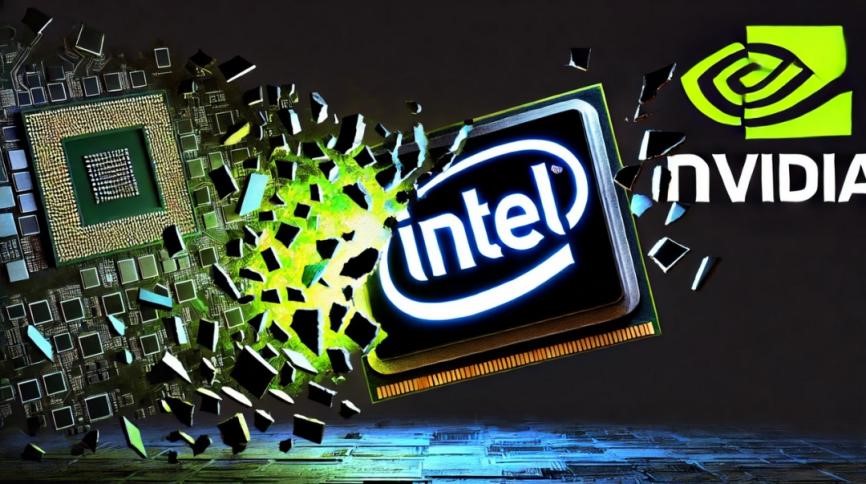In the technology industry, R&D investment is often seen as an important indicator of a company's future growth and innovation capabilities. The fact that Intel, as a giant in the global semiconductor industry, has invested more R&D in R&D than AMD and Nvidia combined, has attracted widespread attention in itself. However, despite Intel's strong investment in R&D, its market value still lags behind its competitors, and the reasons behind this are worth exploring.
Current status of R&D investment
Intel's R&D funding is focused on its core product lines, including central processing units (CPUs), graphics processing units (GPUs), field-programmable gate arrays (FPGAs), and networking devices. As an integrated equipment manufacturer (IDM), Intel has 15 fabs around the world and invests heavily in new semiconductor production processes every year. The development of each new generation of processes often requires billions of dollars in upfront R&D investment. In addition, Intel is developing advanced packaging technologies that require huge amounts of money to develop and maintain.
Compared to Intel, Nvidia and AMD have a relatively high market capitalization, although they have lower R&D investment. Nvidia, for example, spent $3.090 billion on R&D this fiscal year, mainly investing in data center GPUs, consumer GPUs, networking equipment, and data processing units (DPUs) in the fields of artificial intelligence (AI) and high-performance computing (HPC). Nvidia has set a cadence for releasing a generation of AI products each year, so increasing R&D spending is necessary to stay ahead of the curve. AMD also invested $1.583 billion in R&D, mainly for consumer and data center CPU and GPU products, as well as FPGAs and Pensando DPUs. AMD's significant investment in basic R&D technologies, such as High Bandwidth Memory (HBM), enables it to launch new AI GPUs every year.

Figure: Intel has the highest R&D investment, but its market value cannot go up, why is this?
The reason for the lagging market capitalization
However, market capitalization does not depend solely on the amount of R&D invested. A variety of factors, such as market demand, product competitiveness, and company strategy, can also have a significant impact on market capitalization. Intel's market capitalization lags behind despite its huge investment in R&D, which may be related to the breadth and complexity of its product line. Intel has dozens of product categories and thousands of stock-keeping units (SKUs), which results in a split of funds per project that may not be as high as it could be. In addition, Intel's IDM model means that it needs to invest more in manufacturing and R&D, which affects its market capitalization performance to some extent.
Competitors' strategies
In addition to Nvidia and AMD, companies such as Qualcomm and Apple are spending equally well on R&D. Qualcomm invests primarily in system-on-chip (SoC) and RF technologies for consumer devices such as smartphones and PCs, as well as fundamental research in next-generation radio technologies (e.g., 6G). And Apple, although not strictly defined as a semiconductor company, will spend about $27 billion to $29.915 billion on R&D in 2023, more than AMD, Nvidia, and Qualcomm combined. Apple's R&D investment covers a variety of 3C electronics projects from Ion-X glass to M-series processors, and its extensive product layout and deep technology accumulation have made it occupy an important position in the market.
Balance between market demand and technological innovation
In summary, although Intel's R&D investment exceeds that of AMD and Nvidia combined, its market value still lags behind, which may be closely related to factors such as the breadth and complexity of its product line, the high investment in the IDM model, and the high market focus on AI and HPC. In the tech industry, R&D investment is one of the key success factors, but not the only determining factor. Companies need to maintain technological innovation while also paying attention to market demand and product competitiveness to achieve market value growth.
With the continuous change of the market and the rapid development of technology, Intel needs to re-examine its R&D strategy, focus on the core needs of the market, rationally allocate resources, and avoid inefficiencies caused by excessive dispersion. Only by finding a good balance between R&D and the market can Intel regain its advantage in the fierce competition.
In the future, Intel should pay more attention to the market adaptability and competitiveness of its products to improve its market position and market value. At the same time, strengthening the interaction with customers and the market, and obtaining first-hand market feedback, will help them better adjust the direction of research and development. This is the only way to sustain the company's growth and maintain its leadership position in the fast-changing technology industry.






